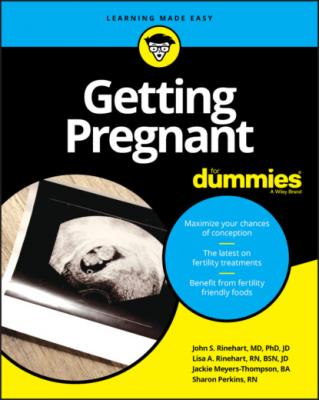Getting Pregnant For Dummies. Sharon Perkins
Читать онлайн.| Название | Getting Pregnant For Dummies |
|---|---|
| Автор произведения | Sharon Perkins |
| Жанр | Секс и семейная психология |
| Серия | |
| Издательство | Секс и семейная психология |
| Год выпуска | 0 |
| isbn | 9781119601234 |
362 371
363 372
364 373
365 374
366 375
367 376
368 377
369 378
370 379
371 380
372 381
373 382
374 383
375 384
376 385
377 386
378 387
379 388
380 389
381 390
382 391
383 392
384 393
385 394
386 395
387 396
388 397
389 398
390 399
391 400
392 401
393 402
394 403
395 404
396 405
397 406
398 407
399 409
400 410
401 411
402 412
403 413
404 414
405 415
406 416
407 417
408 418
409 419
410 420
411 421
412 422
413 423
414 425
415 426
416 427
417 428
418 429
419 430
420 431
421 432
422 433
423 434
424 435
425 436
426 437
427 438
428 439
429 440
430 441
431 442
432 443
433 444
434 445
435 446
Introduction
If you’re dealing with infertility, you may feel alone, confused, and depressed over the potential loss of the dream you’ve cherished since childhood: the dream of having a baby of your own.
Infertility is a medical problem for 6–8 million Americans. Deemed a disease by the World Health Organization but debated as a symptom by many professional organizations, insurance companies often deny coverage for its diagnosis and treatment. Many people (the “just relax and you’ll get pregnant” crowd) don’t understand its biological origins, and a few (the “take this magic pill and you’ll get pregnant, guaranteed!” group) even exploit those suffering from it. There is good news on the infertility front, however; not only are medical treatments for infertility making great gains, but there’s also more awareness of the emotional and social effects of infertility. In fact, most reproductive medicine centers like to call themselves fertility centers now.
Getting Pregnant For Dummies was conceived by combining Jackie Thompson’s knowledge of infertility from a patient’s viewpoint, Lisa Rinehart’s wealth of information as an infertility nurse and reproductive law attorney, and Dr. John Rinehart’s 40 years of clinical practice in reproductive medicine. We wrote this book so that patients dealing with infertility will know that they’re not alone and what they may be up against. We hope it finds its way to the bookshelves and nightstands of all the patients who need it to help find the road to their baby.
About This Book
This book is our attempt to help those of you who want to walk into the doctor’s office and not walk out feeling out of control of your own fertility. Our vision is to provide fertility patients — both those at the starting line and those closer to the finish — and the people who love them with as much information as we can on the options available to them. We discuss topics ranging from the scientific to the spiritual.
You can read through this book from front to back and feel confident that you can find the answer to just about any fertility issue, from natural family planning to cloning. But if you’re like most people, you’ll probably look through the table of contents, zero in on the chapters that affect you, and jump directly to them. This book is meant as a resource, which means that you can go back to it whenever a new issue or question arises and find the answer you need without reading through everything that comes before.
This book is meant for people with every degree of fertility expertise, from the novice to the jaded, been-there-done-that patient. The no-tech and low-tech fertility chapters come first, so you can skip them if you’re already a veteran and move right into high-tech and really high-tech stuff found in the second half of the book.
We intersperse personal stories throughout the book; these (we hope!) make interesting reading from the viewpoint of either Lisa (an infertility nurse/attorney), Jackie (an infertility patient), or Dr. R (the IVF doctor). If you skip them, you won’t miss any essential information, although you may miss a few humorous sidelines or “I did it, so you can too” stories.
To help you pick out information from a page, we use the following conventions throughout the text to make elements consistent and easy to understand; the last thing we want to do is confuse you!
New terms appear in italics and are closely preceded or followed by an easy-to-understand definition. Italics are also used for emphasis.
Bold highlights the keywords in bulleted lists.
We think every word in this book is interesting and educational, but we understand that sometimes you just need a quick answer to a burning question. Other times you want to discover everything possible about infertility, even
